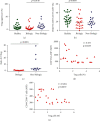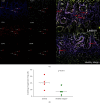Biologic Agents in Crohn's Patients Reduce CD4+ T Cells Activation and Are Inversely Related to Treg Cells
- PMID: 35959163
- PMCID: PMC9357708
- DOI: 10.1155/2022/1307159
Biologic Agents in Crohn's Patients Reduce CD4+ T Cells Activation and Are Inversely Related to Treg Cells
Abstract
Crohn's disease (CD) is a chronic inflammatory disease with a complex interface of broad factors. There are two main treatments for Chron's disease: biological therapy and nonbiological therapy. Biological agent therapy (e.g., anti-TNF) is the most frequently prescribed treatment; however, it is not universally accessible. In fact, in Brazil, many patients are only given the option of receiving nonbiological therapy. This approach prolongs the subsequent clinical relapse; however, this procedure could be implicated in the immune response and enhance disease severity. Our purpose was to assess the effects of different treatments on CD4+ T cells in a cohort of patients with Crohn's disease compared with healthy individuals. To examine the immune status in a Brazilian cohort, we analyzed CD4+ T cells, activation status, cytokine production, and Treg cells in blood of Crohn's patients. Patients that underwent biological therapy can recover the percentage of CD4+CD73+ T cells, decrease the CD4+ T cell activation/effector functions, and maintain the peripheral percentage of regulatory T cells. These results show that anti-TNF agents can improve CD4+ T cell subsets, thereby inducing Crohn's patients to relapse and remission rates.
Copyright © 2022 Eliane Aparecida Rosseto-Welter et al.
Conflict of interest statement
The authors declare that they have no conflicts of interest.
Figures




Similar articles
-
Suppressive and Gut-Reparative Functions of Human Type 1 T Regulatory Cells.Gastroenterology. 2019 Dec;157(6):1584-1598. doi: 10.1053/j.gastro.2019.09.002. Epub 2019 Sep 10. Gastroenterology. 2019. PMID: 31513797
-
Intestinal CD14+ Macrophages Protect CD4+ T Cells From Activation-induced Cell Death via Exosomal Membrane TNF in Crohn's Disease.J Crohns Colitis. 2020 Nov 7;14(11):1619-1631. doi: 10.1093/ecco-jcc/jjaa083. J Crohns Colitis. 2020. PMID: 32343772
-
Lifestyle Intervention Modulates the CD4+ T Cell Profile in the Blood of Crohn's Disease Patients.Inflamm Bowel Dis. 2025 Jan 6;31(1):200-209. doi: 10.1093/ibd/izae154. Inflamm Bowel Dis. 2025. PMID: 39102712 Clinical Trial.
-
Visceral adiposity and inflammatory bowel disease.Int J Colorectal Dis. 2021 Nov;36(11):2305-2319. doi: 10.1007/s00384-021-03968-w. Epub 2021 Jun 9. Int J Colorectal Dis. 2021. PMID: 34104989 Review.
-
Conventional Therapies for Crohn's Disease.Gastroenterol Clin North Am. 2022 Jun;51(2):271-282. doi: 10.1016/j.gtc.2021.12.004. Epub 2022 Apr 22. Gastroenterol Clin North Am. 2022. PMID: 35595414 Review.
References
-
- Hammer T., Langholz E. The epidemiology of inflammatory bowel disease: balance between East and West? A narrative review. Digestive Medicine Research . 2020;3:p. 48. doi: 10.21037/dmr-20-149. - DOI
MeSH terms
Substances
LinkOut - more resources
Full Text Sources
Medical
Research Materials

